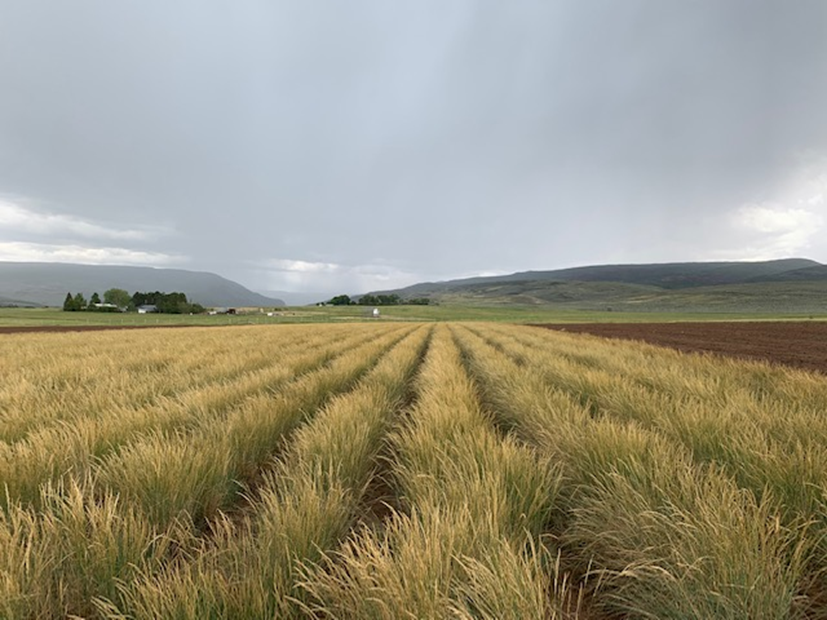Last updated: October 6, 2023
Article
Bipartisan Infrastructure Law funding ensures long-term success of native plants in Western U.S. national parks

NPS photo.
When fire and flood tear through parks and other public lands, ecosystem restoration specialists are ready to restore landscapes to pre-disaster conditions. Their ability to respond is increasingly affected by a changing climate that makes wildland fire and intense storm flooding more common which, in turn, means restoration specialists need more native plants and seed to repair the damage. Disasters such as these also encourage invasive plants, such as cheatgrass and red brome for example, to rapidly gain a foothold in national parks.
With funds from the Bipartisan Infrastructure Law, National Park Service staff in the western United States are at work with partners to grow, collect, store, and distribute seed needed for current and future restoration projects. A lot of seed.
In Bend, Oregon, near John Day Fossil Beds National Monument, the newly established East Cascades Native Plant Facility has become a hub for seed collection and plant propagation for sagebrush and other native plants. Seed and plants will be used for restoration projects in parks across Northern California, Idaho, Oregon, and Washington where sagebrush is an at-risk ecosystem type.
NPS project leads have established this native seed collection and plant propagation facility and information clearinghouse on the Oregon State University (OSU)-Cascades Campus and in partnership with the Bureau of Land Management, U.S. Forest Service, Confederated Tribes of Warm Springs, and private industry. OSU-Cascades will expand into a state-of-the-art native plant materials center that provides seed collection, plant propagation and on the ground restoration. It will also be an information clearinghouse and staff will provide support for vegetation protection, restoration, and translocation, as well as early-career, restoration practitioner workforce development and jobs to university students and Tribal youth.

NPS photo.
One of the project leads, NPS ecologist Tom Rodhouse, has had a front row seat to the rapid fire-driven changes occurring in the parks. "We are really encouraged by the level of collaboration and enthusiasm among all of our partners,” he said. “Clearly the shortage of native plant materials for post-fire restoration and climate adaptation has been felt by everyone and this investment has created exciting opportunities and forward momentum."
This project supports the 2015 National Seed Strategy for Rehabilitation and Restoration which fosters interagency collaboration to grow, collect, store and distribute seed needed for restoration projects. It also enhances long-term climate adaptation and ecosystem restoration goals across landscapes – a key piece of the National Seed Strategy.

NPS photo.
Additional seed production efforts are underway in national parks including Yellowstone National Park, Grand Teton National Park, Saguaro National Park, Organ Pipe National Monument, and Zion National Park. These efforts, also funded by the Law, build capacity to scale up collection, production, and storage of seeds for native species found to support grassland, sagebrush, and southwestern desert ecosystems.
Beyond the beauty of these natural areas and seeing the abundant, thriving life there, restoring and protecting healthy natural areas benefits people, animals, plants, and their shared environment. That means, the support of these natural features through Bipartisan Infrastructure Law funding enhances the overall enjoyment for national park visitors, too.
“Returning sufficient and appropriate native plants to areas disturbed by natural disasters, park construction activities, invasive plant introductions, etc. ensures sufficient and appropriate food sources and habitat conditions for local wildlife,” said NPS botanist Steven Bekedam. “Without it, wildlife populations would likely decline and/or migrate to other locations taking away from prime wildlife viewing opportunities.”
In addition, Bekedam says visitors may also benefit by more opportunities to engage in educational activities in parks, such as citizen science programs that allow visitors to form deeper connections with a park or learning about the traditional use of plants.
To date, this project has directly supported the National Seed Strategy by allowing Grand Teton National Park to purchase seed cleaning equipment, fund agreements with the Grand Teton Conservation Corps and Great Basin Institute youth corps programs to plan and perform seed collection activities, and contract with the Upper Colorado Environmental Plant Center to grow several high priority restoration species in 2023.
Because of this project, native seed production will occur in Colorado and at least eight parks in the Colorado Plateau and Rocky Mountains Ecoregions in Utah and Wyoming, significantly increasing access to native seeds to meet planned and emergent ecosystem restoration needs. Utilizing and sharing native, eco-regionally adapted seed for restoration meets the Department of Interior’s conservation and restoration priorities of working across larger scales and boundaries, while also enhancing climate resiliency.
